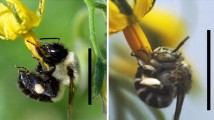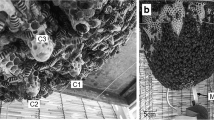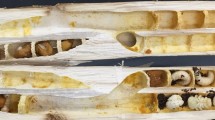Abstract.
Worker piping, previously reported only in hives, was observed in swarms as they prepared to liftoff to fly to a new home. Pipers are excited bees which scramble through the swarm cluster, pausing every second or so to emit a pipe. Each pipe consists of a sound pulse which lasts 0.82±0.43 s and rises in fundamental frequency from 100–200 Hz to 200–250 Hz. Many, if not all, of the pipers are nest-site scouts. The scouts pipe when it is time to stimulate the non-scouts to warm themselves to a flight-ready temperature (35°C) in preparation for liftoff. The time-course of worker piping matches that of swarm warming; both start at a low level, about an hour before liftoff, and both build to a climax at liftoff. When we excluded pipers from bees hanging in the cool, outermost layer of a swarm cluster, we found that these bees did not warm up. The form of worker piping that we have studied in swarms differs from the form of worker piping that others have studied in hives. We call the two forms "wings-together piping" (in swarms) and "wings-apart piping" (in hives).
Similar content being viewed by others
Author information
Authors and Affiliations
Additional information
Electronic Publication
Rights and permissions
About this article
Cite this article
Seeley, T.D., Tautz, J. Worker piping in honey bee swarms and its role in preparing for liftoff. J Comp Physiol A 187, 667–676 (2001). https://doi.org/10.1007/s00359-001-0243-0
Accepted:
Issue Date:
DOI: https://doi.org/10.1007/s00359-001-0243-0




